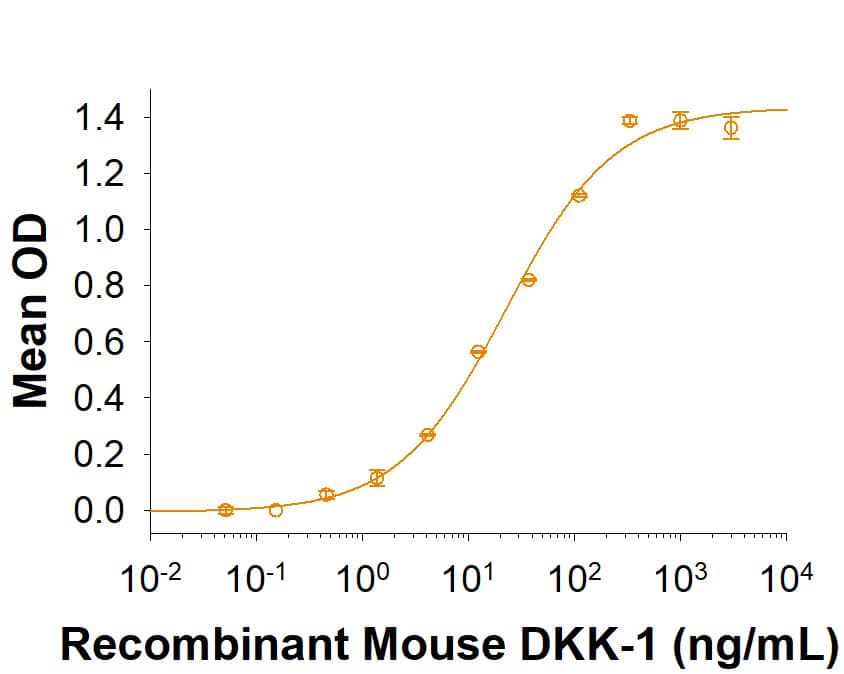Recombinant Mouse LRP-6 N-Terminal Fragment Fc Protein, CF
R&D Systems, part of Bio-Techne | Catalog # 9950-LR

Key Product Details
Source
CHO
Accession #
Structure / Form
Disulfide-linked homodimer
Conjugate
Unconjugated
Applications
Bioactivity
Product Specifications
Source
Chinese Hamster Ovary cell line, CHO-derived mouse LRP-6 protein
| Mouse LRP-6 (Ala20-Ile628) Accession # NP_032540 |
IEGRMDP | Mouse IgG2a (Glu98-Lys330) |
| N-terminus | C-terminus |
Purity
>90%, by SDS-PAGE visualized with Silver Staining and quantitative densitometry by Coomassie® Blue Staining.
Endotoxin Level
<0.10 EU per 1 μg of the protein by the LAL method.
N-terminal Sequence Analysis
Ala20
Predicted Molecular Mass
96 kDa
SDS-PAGE
100-120 kDa, reducing conditions
Scientific Data Images for Recombinant Mouse LRP-6 N-Terminal Fragment Fc Protein, CF
Recombinant Mouse LRP-6 N-Terminal Fragment Fc Protein SDS-PAGE
2 μg/lane of Recombinant Mouse LRP‑6 N-Terminal Fragment Fc Chimera was resolved with SDS-PAGE under reducing (R) and non-reducing (NR) conditions and visualized by Coomassie® blue staining, showing bands at 100-120 kDa and 200-220 kDa, respectively.Formulation, Preparation and Storage
9950-LR
| Formulation | Lyophilized from a 0.2 μm filtered solution in PBS. |
| Reconstitution | Reconstitute at 500 μg/mL in PBS. |
| Shipping | The product is shipped at ambient temperature. Upon receipt, store it immediately at the temperature recommended below. |
| Stability & Storage |
|
Background: LRP-6
References
- Joiner, D.M. et al. (2013) Trends Endocrinol. Metab. 24:31.
- Pinson, K.I. et al. (2000) Nature 407:535.
- Brown, S.D. et al. (1998) Biochem. Biophys. Res. Commun. 248:879.
- He, X. et al. (2004) Development 131:1663.
- Ai, M. et al. (2005) Mol. Cell. Biol. 25:4946.
- Gong, Y. et al. (2010) PLoS One 5:e12682.
- Itasaki, N. et al. (2003) Development 130:4295.
- Mao, B. et al. (2001) Nature 411:321.
- Zhang, Y. et al. (2004) Mol. Cell. Biol. 24:4677.
- Bourhis, E. et al. (2010) J. Biol. Chem. 285:9172.
- Ahn, V.E. et al. (2011) Dev. Cell 21:862.
- Li, C. et al. (2013) J. Bone Miner. Res. 28:2094.
- Riddle, R.C. et al. (2013) PLoS One 8:e63323.
Long Name
LDL Receptor-related Protein 6
Alternate Names
ADCAD2, FLJ90062, FLJ90421, LRP6
Gene Symbol
LRP6
UniProt
Additional LRP-6 Products
Product Documents for Recombinant Mouse LRP-6 N-Terminal Fragment Fc Protein, CF
Product Specific Notices for Recombinant Mouse LRP-6 N-Terminal Fragment Fc Protein, CF
For research use only
